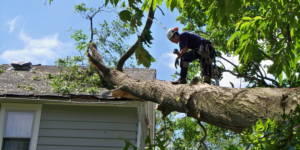Windows add to a home’s curb appeal, security and energy efficiency. But they can wear down over time, requiring replacement.

If your windows don’t open or close as easily as they used to, it may be time to call a professional window specialist. It’s important to address this problem as soon as possible to prevent further damage to the window frames, door lock or locking mechanisms and other components of the system. Contact Window Replacement Rockville MD for professional help.
Difficulty opening or closing can be caused by a variety of factors. For instance, dirt or debris can build up between the window frame and the sash. This can cause the sash to become misaligned and interfere with the operation of the window. Window experts recommend cleaning and lubricating the window regularly to prevent this from happening.
Another common reason why windows may be difficult to open is that the window spring has become too tight. This is a piece of hardware that is hidden inside the window jamb and it supports the sash. If this becomes too tight, it will make it impossible to open the window. The good news is that this can be fixed by adjusting the spring, which is not a difficult job for a professional.
You can also try using a lubricant like WD-40 to loosen up any parts that are stuck or moving stiffly. It is important to open and close the window a few times to work the lubricant into the parts and spread it evenly. If this doesn’t resolve the issue, then you may need to replace the window springs, which again is not a difficult process for a professional.
If the problem persists, it’s possible that there are structural issues with the house foundation that are causing the windows to move out of alignment. This is a problem that can be expensive to fix and will require a professional assessment and possible replacement of the window system.
Warped or Rotting Frames
While a minor crack or chip can be repaired, window frames that warp, rot, or become misshapen will require replacement. Various factors contribute to this issue, including weather conditions, accidents, and ageing. Whether your windows are made from wood or vinyl, a warped frame is not only unsightly but also poses a serious health and safety risk for the entire household. Moreover, it leads to leaks and water intrusion into the wall which can lead to dampness and mould.
Window rot can compromise your home’s structural integrity and also make it difficult to open or close the window. This is because rotten wood shrinks, creating minuscule gaps in the window sash and frame that let air pass through. This leads to high utility bills as heating and cooling systems struggle to reach the desired indoor temperature.
The best way to spot rot is to look for spongy or crumbly spots on the wood surface. You can use your finger or a screwdriver to probe the area, as it is likely that the problem is concentrated in corners and joints.
It is also a good idea to inspect your windows for peeling or bubbling paint as this can be a sign of trapped moisture underneath the surface. If left unattended, this can lead to rot and even mould.
In addition to causing draughts, a warped window can also reduce the energy efficiency of your home. This is because minuscule gaps between the window sash and frame allow treated air to escape, forcing your heating and cooling systems to work harder in order to maintain a comfortable indoor temperature.
In some cases, you may be able to correct the problem by loosening the hinges and then filling in the gap with extra wood filler. However, this is a temporary fix and should only be used as a Band-Aid to prevent further damage.
Damaged Glass
A window is an important part of any home, but it can take quite a beating. From harsh weather conditions to accidents and vandalism, there’s no avoiding damage to glass windows. While some types of damage are easily repairable, others require full replacement to ensure the safety and functionality of your windows.
Typically, the easiest repair to perform on a cracked or shattered window is to simply replace it with a new pane of glass. This is especially true if the crack or shattered glass is causing structural issues with your home.
Small surface-level cracks and chips can be repaired with a glass repair kit. These kits contain resin that can fill in cracks and prevent them from spreading. This type of repair is mostly cosmetic, but it can significantly improve the appearance of your window and minimize the risk of breakage.
Another common problem that may cause a need for a window replacement is if your home is experiencing thermal leaks. Leaks can occur for a number of reasons, including weather damage, poor insulation, and even wood framing issues. These leaks can cause significant energy loss and, if left untreated, can result in structural problems and mold growth.
If your home is experiencing leaking windows, it’s best to have these repaired as soon as possible. This can save you money on your energy bills and prevent further damage to your home.
Accidents — It’s not uncommon for kids to accidentally throw a ball through a window, or for someone to hit a home with a golf club. Regardless of the cause, broken glass isn’t something homeowners want to deal with. It can be costly and difficult to repair, so many choose to replace their windows instead.
Vandalism — Vandalism can take a variety of forms, but it’s most often seen as spray-painted graffiti or defaced property. Not only is this embarrassing and unsafe, but it can also lead to expensive repairs and insurance claims.
There’s not much you can do to stop natural disasters or act of vandalism, but you can take steps to protect your windows. For example, it’s not uncommon to install hurricane shutters to help protect your windows from high winds. You can also make sure your windows are properly engineered to withstand strong weather conditions.
Security Issues
Whether you live in downtown Pittsfield or on the outskirts of town, home security is always a concern. While living in the Berkshires has its perks, including stunning fall foliage and charming small-town life, it’s important to protect your home from burglars and other intruders. Window replacement is one way to boost your home’s security, while reducing energy costs.
Windows are a common entry point for intruders, and older windows often make it easy for burglars to enter your home. Older windows have single-pane glass, which is easier to break with a well-aimed rock or elbow jab. In contrast, newer windows are made with much stronger materials and come equipped with multiple locking mechanisms. They also feature tempered or laminated glass that is more difficult to break and does not shatter into easy-to-move pieces.
Newer windows can also be fitted with window sensors that detect if the window is opened or broken, and trigger an alarm that can scare off any potential intruders. While these features aren’t necessary for everyone, they can help you feel safer in your home.
When it comes to window maintenance, regular cleanings and inspections are vital to preventing damage and keeping your windows in top condition. But if you notice that your windows are becoming difficult to open or close, or if they have damaged seals and frames, it’s time to consider window replacement.
If your windows aren’t working as they should, it’s likely due to the natural settling of your home or the wear and tear on the window components. Difficulty opening and closing your windows isn’t just a nuisance; it can be dangerous in an emergency situation. A broken window can also compromise your home’s security, so it’s essential to replace it promptly. By choosing high-quality materials and experienced glaziers, you can ensure that your new windows will be a lasting asset to your home.
